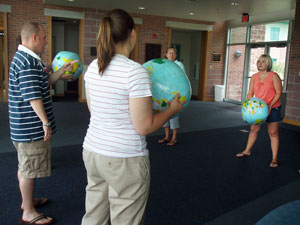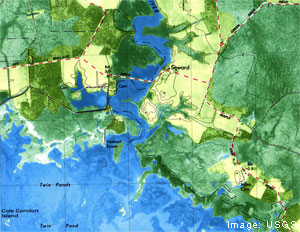
LEARN ABOUT OBSERVING THE OCEAN
Why do we observe the ocean?
How do we observe the ocean?
Students explore what kind of information can be obtained from ocean observing systems by accessing online buoy data.
EXPLORE OCEAN PHYSICS
The motion of the ocean
Students construct a clay model to become familiar with the forces which produce circulation patterns in ocean basins and to predict patterns or eddy development with variances in bathymetery (Developed by COSEE-Southeast)
Students use Ocean Observing System data to examine the Gulf Stream.
Field activity in which students use drifters to study surface currents (Developed by COSEE-Southeast).
Density: Sink or Float?
This activity demonstrates density differences in ocean and coastal waters and how these differences drive currents.
Students determine if water is mixed or stratified through a field activity and compare field data to data from observing systems to assess the advantages and disadvantages of the two methods of data collection.
Currents affect climate and weather
Students will use current and yearly average temperature data to assess how the ocean affects air temperatures.
Extreme Events: Oceans Impact Coastal Areas
Students use topographic maps and tide data to explain what areas of the coastline will be flooded in a given number of years. They also predict the extent of flooding due to storm surge (Developed by COSEE-Southeast and COSEE-Coastal Trends).
Students track a hurricane using latitude and longitude. They also learn about a hurricane's formation and the amount of devastation it caused.
EXPLORE MARINE LIFE
Young Fish and shellfish are at the mercy of currents
Hatch to Catch: Interactive online activity in which students determine factors contributing to larvae survival.
Where Could the Stripers Be?: Students determine
where striped bass in the Chesapeake Bay can live based on temperature and dissolved oxygen conditions.
Global climate change may affect where aquatic organisms can live
Students use real-time ocean temperature data to predict the distribution of marine organisms.
Additional Resources
![]() Science Presentation: The Coastal Ocean: Estuaries and Continental Shelves: How do they move, how do we know this, and what's happening in the long run? Dr. Bill Boicourt, University of Maryland
Science Presentation: The Coastal Ocean: Estuaries and Continental Shelves: How do they move, how do we know this, and what's happening in the long run? Dr. Bill Boicourt, University of Maryland






